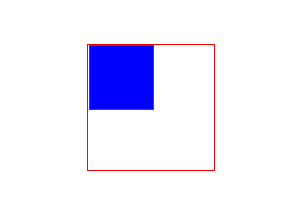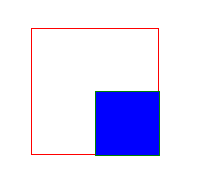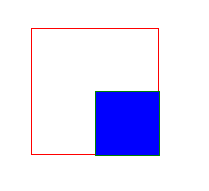一.定位分三种:相对定位,绝对定位和固定定位。
1.相对定位:元素所占据的文档流的位置保留,元素本身相对自身原位置进行偏移;
如下:
<!DOCTYPE html>
<html lang="en">
<head><meta charset="UTF-8"><meta name="viewport" content="width=device-width, initial-scale=1.0"><meta http-equiv="X-UA-Compatible" content="ie=edge"><title>定位</title><style>.box1{margin: 50px auto;border: 1px solid red;width: 100px;height: 100px;}.box2{width: 50px;;height: 50px;border: 1px solid green;background: blue; position: relative; # 相对定位left: 50px;top: 50px;}</style>
</head>
<body><div class="box1"><div class="box2"></div></div>
</body>
</html>
定位前: 定位后:


2.绝对定位:元素脱离文档流,不占据位置,漂浮在文档流的上方,相对于父级元素进行定位;
前提是父级元素设置了定位,一般是设置相对定位;如果找不到就会相对于body进行定位,相当于固定定位。
<!DOCTYPE html>
<html lang="en">
<head><meta charset="UTF-8"><meta name="viewport" content="width=device-width, initial-scale=1.0"><meta http-equiv="X-UA-Compatible" content="ie=edge"><title>定位</title><style>.box1{margin: 50px auto;border: 1px solid red;width: 100px;height: 100px;position: relative; # 父元素设置了定位}.box2{width: 50px;;height: 50px;border: 1px solid green;background: blue;position: absolute; # 子元素设置相对定位left: 50px;top: 50px;}</style>
</head>
<body><div class="box1"><div class="box2"></div></div>
</body>
</html>
结果:

3.固定定位:元素脱离文档流,不占据文档流的位置,漂浮在文档流的上方,其相对于浏览器窗口进行定位。
<!DOCTYPE html>
<html lang="en">
<head><meta charset="UTF-8"><meta name="viewport" content="width=device-width, initial-scale=1.0"><meta http-equiv="X-UA-Compatible" content="ie=edge"><title>定位</title><style>.box1{margin: 50px auto;border: 1px solid red;width: 100px;height: 100px;}.box2{width: 50px;;height: 50px;border: 1px solid green;background: blue; position: fixed; # 固定定位left: 50px;top: 50px;
}</style>
</head>
<body><div class="box1"><div class="box2"></div></div>
</body>
</html>
结果:box2相对于窗口定位。


)




作业.docx)

第10章空间形体的三维重建与图像处理.ppt...)


)







